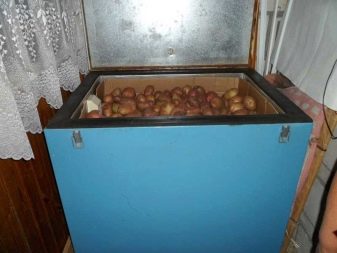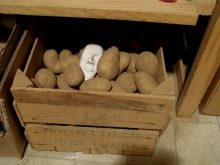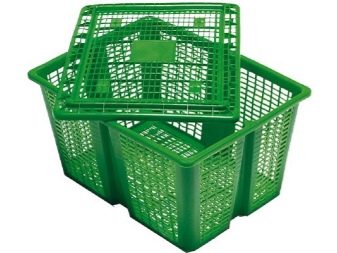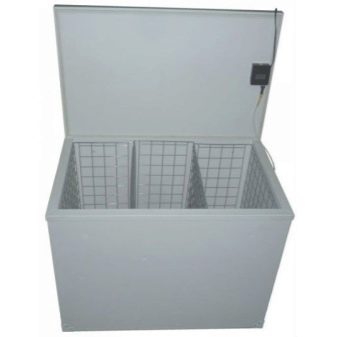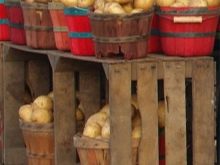How to store potatoes on the balcony?
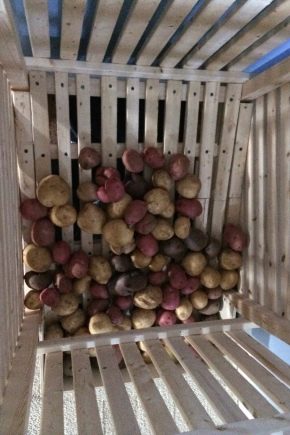
Storage of potato tubers in summer, spring and winter is allowed not only in a cellar or basement, but also on a balcony. However, for this, a number of factors must be taken into account. Otherwise, there is a risk that the potato crop will deteriorate and become unusable. How to properly store potatoes in an apartment and what containers to use for this, we will tell below.
Basic rules and shelf life
Potatoes are a staple part of the diet for many people. Most grow it in the garden, but not everyone has the opportunity to store it in basements and cellars. This is especially true for those people who live in apartments. In this case, the balcony comes to the rescue. It is he who is most often used for storage.
However, it is not enough to allocate space for storing potato tubers. It is also required to provide them with favorable conditions, otherwise there is a risk that the potatoes will begin to sprout, rot or rot.
- To properly store potatoes on the balcony, first of all, it is worth getting rid of those fruits that have begun to rot, have been deformed or damaged. If this is not done, the likelihood is high that subsequently healthy potatoes will begin to deteriorate, and you will simply lose your crop.
- Do not store wet tubers either. They tend to quickly deteriorate and germinate ahead of time. Therefore, it is worth taking the time to dry the potatoes. At the same time, you should not wash it before sending it to the balcony. Unwashed tubers are stored several times longer. It is advisable to wash them only if in the near future you plan to use them for cooking and eating. Nevertheless, it is still worth removing the adhering soil from the potatoes, but this must be done in such a way as not to damage the potato peel.
- Please note that it is necessary to pay attention to the arrangement of the balcony. There should be no drafts, especially in winter. In this case, the fruits must have access to fresh air, which can be provided with the help of ventilation. Note that the potatoes also need to be protected from light. It should not be exposed to sunlight. Even artificial lighting will be disastrous for him. Otherwise, the potato tubers will change their color to green - this will indicate that such a dangerous substance as solanine has begun to accumulate in it. You will have to get rid of such fruits, since they are not suitable for food and can cause great harm to the human body.
- The humidity of the air masses on the balcony should not exceed 85%, and the temperature should vary between 2 and 4 degrees. At higher temperatures, potatoes will feel the same as in spring, which is why they will begin to germinate, which is fraught with wilting, drying out and a decrease in taste. At low air temperatures, the potatoes will also begin to deteriorate and rot, and at a level below 0 degrees, the potatoes acquire a sweetish taste.
- Do not allow sudden temperature fluctuations. Potatoes will be able to tolerate minor jumps from 0 to +10 degrees, but they should not be long.
- For storing potatoes, a room that will be dark and dry is perfect. Ideally, this is a constantly heated glazed loggia or balcony, since such rooms are best protected from unwanted drafts. If there is no heating on the balcony, then the storage of vegetables is allowed here only in warm winter conditions.At the same time, the room must also ensure good circulation of air masses, as well as protection from moisture and parasites.
- Under other favorable conditions, you can store potatoes on the balcony from autumn to spring. Avoid changes in moisture level and temperature, ventilate the room to prevent the development and spread of vegetable rot, and then your potatoes will be in perfect order.
- When choosing a balcony for storing potatoes, you should also take into account the peculiarities of the local climate. So, in regions with very cold and long winters or, on the contrary, with high temperatures in the southern regions, you will have to work several times more to create the necessary conditions. The easiest thing is for those who live in central Russia.
As for the shelf life, if all the above conditions are met, potatoes can be stored throughout the winter. The shelf life still depends on the variety and quality of the potato.
Choosing a capacity
Choosing the right container is essential for storage.
Boxes
A wooden box or box is the most obvious option for storing potato tubers. The tree will provide full circulation of air masses, which will exclude the possibility of rotting vegetables. It is best to choose storage boxes that have a side vent for ventilation. The wall thickness of such a box should be about 5 centimeters.
At the same time, it is best to place boxes on racks or shelves, since a cold floor can negatively affect the general condition of the potatoes.
Otherwise, it is recommended to equip the boxes with additional heating.
Drawers made of plastic with holes are also suitable for storing potatoes. It is also better not to place them on the floor in order to prevent hypothermia.
At the same time, before storage, boxes, whether they are plastic or wooden, must be thoroughly rinsed and dried.
Regardless of whether you have used them or not, it is also recommended to disinfect them. This can be done with water, baking soda and soap. Separately, it is worth treating the box with a special solution of copper sulfate. Only then can the potatoes be put into the boxes.
If you need to additionally insulate the storage boxes, you can use an old mattress, blankets, foam or corrugated cardboard for this, which requires several layers to wrap the box.
Factory made thermoboxes
Thermoboxes are a more modern device that you can buy in a specialty store. This is a financially costly device, but it is great for storing potatoes in an apartment and can be an excellent replacement for cellars and basements. Thermobox is an automated container that looks like a small refrigerator.
The required temperature in such a box can be set by the owner of the device. By the way, they provide forced ventilation on many, which also favorably develops on potato tubers.
Temporary packaging
A temporary container is a container in which potatoes are stored for a short period of time. Most often, such containers are used only in cases where it is required to store a small number of tubers. In addition, they are also suitable for keeping potatoes there until a full container is purchased.
Among such containers are cardboard boxes, as well as ordinary rag and mesh bags.
Possible mistakes
If the potato turns green during storage, rots, dries up or shrinks, then this indicates that its owner makes mistakes during storage.
- Potatoes can start to deteriorate due to the wrong variety being selected. If you plan to store tubers in the winter, then for this it is worth choosing exclusively late varieties, early potatoes simply cannot be stored for a long time and will begin to deteriorate.At the same time, it is desirable that the potato variety has a thick skin, which will provide the fruit with good protection.
- Another mistake is storing low-quality tubers. Even one rotten or damaged potato can harm the rest of the healthy and intact tubers. Therefore, carefully inspect the fruits before storing. Get rid of the spoiled ones, and set aside those that were accidentally cut with a shovel so that you can eat them in the near future.
- Lack of balcony ventilation is another common mistake. To preserve the potato harvest, the balcony needs to be opened for at least a few minutes to give fresh air access.
- Potatoes also need to be inspected regularly. Otherwise, you may not notice a minor focus of decay, which is fraught with loss of yield. If rot occurs and spoiled potatoes are removed in a timely manner, healthy potatoes will remain intact.
- It is also not recommended to store potatoes with "neighbors" in the form of other vegetables, as they can negatively affect its taste and general condition. However, potatoes get along well with beets. This vegetable can even significantly reduce the risk of potato rotting. To do this, lay the beets on top of the potatoes, thereby providing them with protection.
- For the same purpose, you can also use garlic, which you want to chop., as well as leaves of wormwood or mountain ash and onion husks. And using straw and sawdust will help remove excess moisture.

